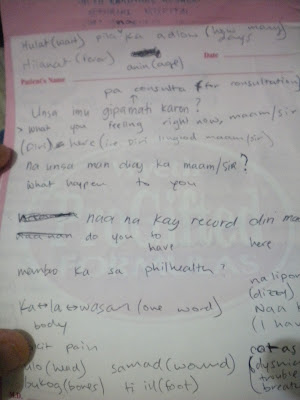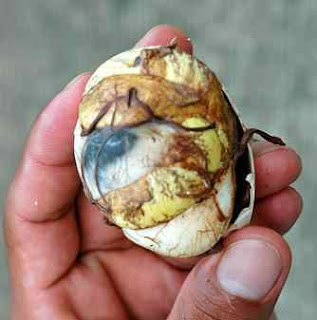So I have my schedule for the next
three months. I'll be rotating morning (700-1300), swing (1300-1900),
and noc (1900-700) shifts between the emergency room/outpatient
department and the nurses station/ward (which is inpatient care).
November 6-16: ER/OPD (Morning)
November 19-29: Nurses Station/Ward
(Morning)
December 3-7: ER/OPD (Swing)
December 10-14: Nurses Station/Ward
(Swing)
December 17-21: ER/OPD (Noc)
December 26-28: Nurses Station/Ward
(Noc)
January 2-4: ER/OPD (Morning)
January 7-11: Nurses Station/Ward
(Morning)
January 14-18: ER/OPD (Swing)
January 21-25: Nurses Station/Ward
(Swing)
January 28-31: Nurses Station (Morning)
Today was mostly orientation and I got
an idea of how the Julio Cardinal Rosales Memorial Hospital operates.
There are five doctors but only one attending physician at a time.
They work 24hr shifts for five days, then switch (and I thought back
to back doubles were hard). There is one general practitioner, two
internal medicine specialists, and two pediatricians. They have three
OR's which are attended by a surgeon every Saturday and Sunday and
one delivery room which is used by the midwives, but an obstetrician
visits every Sunday. The hospital isn't set up for major surgery
(there is no anesthesiologist), so whenever there are sever injuries
(i.e. stab wounds, gunshot wounds, severe motor accidents, etc) they
stabilize and refer them to the nearest hospital equipped to handle
major surgeries...which is an hour away.
What this means is the medicine
practiced here is purely clinical. They have an x-ray machine and a
lab that can process some hematology measurements including CBC's as
well as biochemical (lipid counts, blood sugar, etc), urinalysis, and
fecal tests, but other than that it's just good old fashioned
use-your-brains-clinical-diagnosing. One of the nurses asked if I
wanted to perform an allergy skin test injection, but since I've
never injected anything, I figured I should at least observe first.
I want to give you a perspective of the
remoteness of this place compounded with the poverty, but before I
do, please consider the following words carefully: It is easy to
practice sterile medical procedures when a country is wealthy. This
is a poor country, filled with the poor, and healed by the poor. Most
of the western sterilization practices are not done here simply
because they do not have the means to do so. They do, however, practice clean techniques whenever possible. You can condemn them for
not practicing sterile procedures, but when it comes down to it,
would you deny treatment to an entire region simply because they
can't adhere to standards that are above their fiscal means? I
certainly hope not.
Ok, go.
All of the toilets here (including
those at the hospital) do not have conventional pressurized flushing
systems. Every time you need to eliminate waste, you have to fill up
a bucket of water and pour it into the toilet. On top of that, the
water (in the homes, at least) stops running at 7:00AM. I still
haven't figured out when they turn back on.
Disposable gloves are hardly ever used.
I worked about five hours in the ER today and one patient (a child)
had a broken arm that wasn't set properly because he wasn't brought
in for treatment until a few weeks after the break. The attending
physician had to inject directly into the bone, and this was the one
time I saw disposable gloves used (probably because the risk of
infection was greater due to the depth of the injection).
The only soap I can find is in the
kitchens. Other than that, alcohol based solutions are used in lieu
of soap. However, most of those alcohol based solutions are either
out, running low, or very hard to find.
Temperatures are only taken axillary
and probe covers are nonexistent.
The pay the RN's and midwives receive
are below the minimum wage set
by the government. Here, private companies are allowed to set their
own wages (it's only government positions that must adhere to the
minimum wage law). Since the hospital is run by a cloister of nuns,
the finances (including the wages for the workers and the upkeep of
the hospital) are completely dependent on the amount of patients it
receives. I realize this is similar to private practice hospitals in
the US, but let me walk you though a typical bill. Dengue fever is a
common ailment here especially among the young. Today a patient
presented symptoms of Dengue fever so a UA and CBC was order to
confirm the diagnosis. Intravenous Ampicillin was prescribed (even
though Dengue fever is viral, I think an antibiotic was given since
the patient was in an at-risk demographic for opportunistic
infections) along with a skin test to confirm the patient wasn't
allergic to the antibiotics. PRN Paracetamol was also prescribed,
given orally, to reduce the fever. The cost of all of this (IV bag,
meds, tape for the needle) including the consultation fee? Around
₱1400,
which is roughly $34. I asked the nursing staff if this was
considered expensive in this particular region and they said yes.
Imagine trying to run a private hospital when $34 is considered
expensive.
If you
still can't imagine how remote this place is, imagine waking up to
30-40 rooster cock-a-doodle-dooing around 5:00AM (it sounds like an
exaggeration, but everyone here has roosters and chickens and pigs).
Then imagine six dogs right next to your window barking because
they're there to guard said roosters. Imagine for every house there's
at least one gecko, that you can see, just chilling out on the
ceilings and walls.
This
place is alive and actively reminds me that the pinnacle of human
“civility” and “achievement” is built upon human compassion,
ingenuity, and the unrelenting tenacity people have to thrive in any
environment.
To
leave you on a lighter note, today I tried balut.
If you have a weak stomach consider this your warning.
This is balut (according to Wikipedia, which I can now verify): A balut is a fertilized duck embryo that is boiled and eaten in the shell. It is commonly sold as streetfood in the Philippines.
Here is what it looks like (taken from google because, like a dummy, I left my camera charger at home):
.png)
.png)
.png)
.png)
.JPG)
.JPG)



.JPG)
.JPG)


.JPG)
.JPG)

.JPG)
+To+Dalaguete+(1).JPG)





